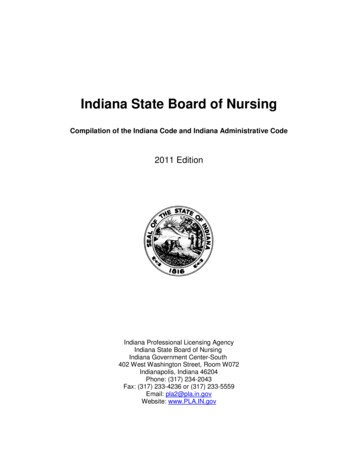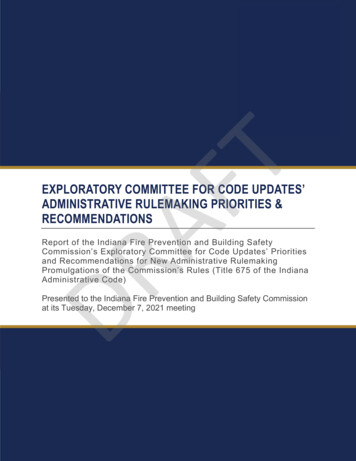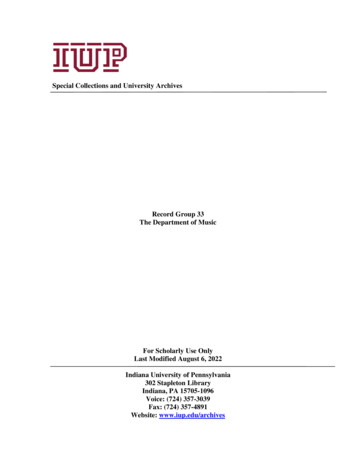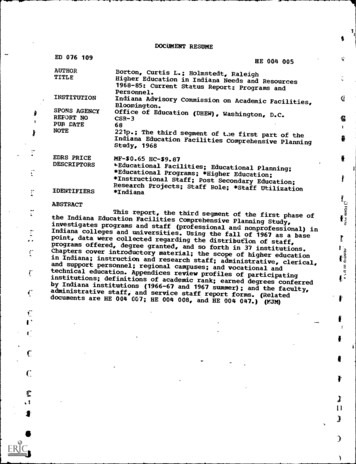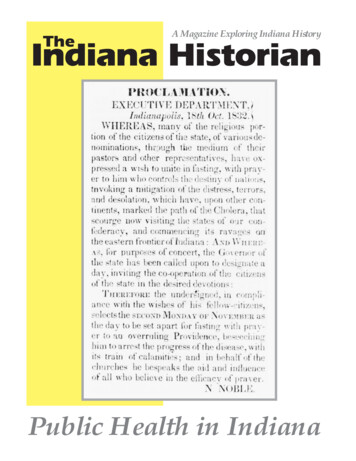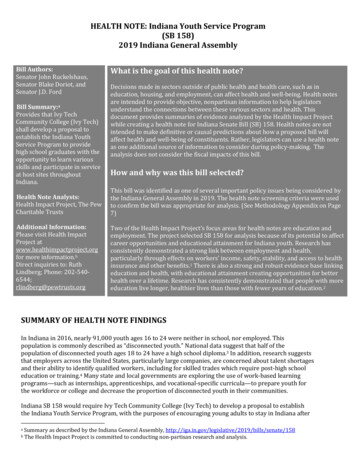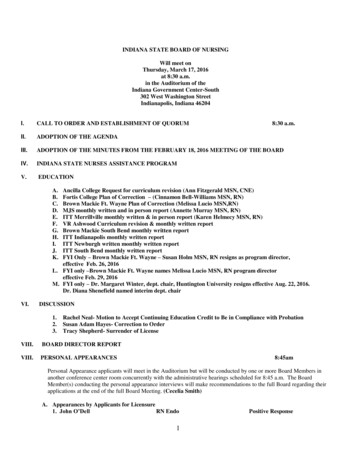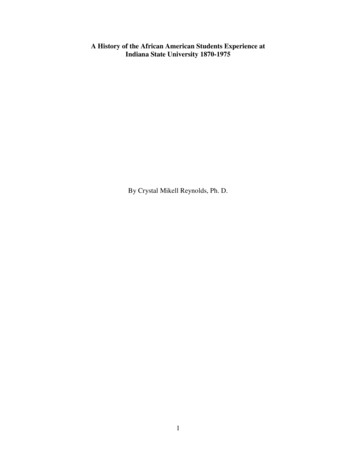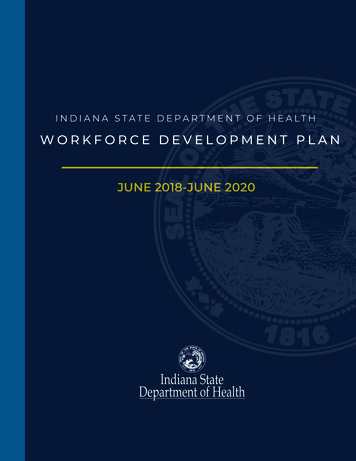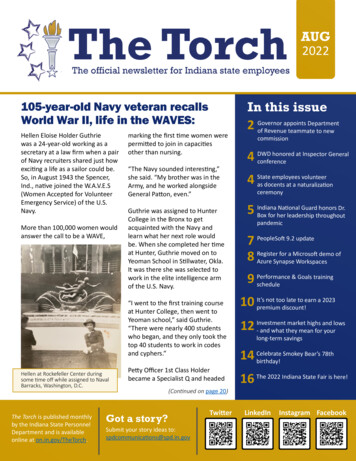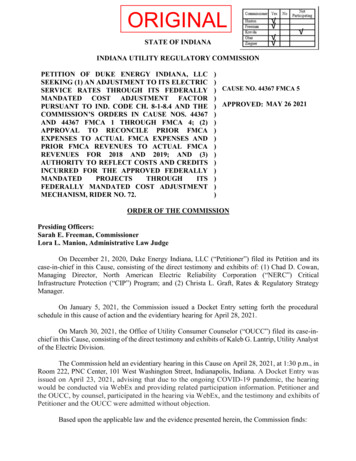
Transcription
ORIGINALCommi11i.oner Yes11111110n"l'reemanKuvda- berSTATE OF INDIANA--Z1egner NoNotPutic1p tmg INDIANA UTILITY REGULATORY COMMISSIONPETITION OF DUKE ENERGY INDIANA, LLCSEEKING (1) AN ADJUSTMENT TO ITS ELECTRICSERVICE RATES THROUGH ITS FEDERALLYMANDATED COST ADJUSTMENT FACTORPURSUANT TO IND. CODE CH. 8‐1‐8.4 AND THECOMMISSION’S ORDERS IN CAUSE NOS. 44367AND 44367 FMCA 1 THROUGH FMCA 4; (2)APPROVAL TO RECONCILE PRIOR FMCAEXPENSES TO ACTUAL FMCA EXPENSES ANDPRIOR FMCA REVENUES TO ACTUAL FMCAREVENUES FOR 2018 AND 2019; AND (3)AUTHORITY TO REFLECT COSTS AND CREDITSINCURRED FOR THE APPROVED FEDERALLYMANDATEDPROJECTSTHROUGHITSFEDERALLY MANDATED COST ADJUSTMENTMECHANISM, RIDER NO. 72.))) CAUSE NO. 44367 FMCA 5)) APPROVED: MAY 26 2021)))))))))))ORDER OF THE COMMISSIONPresiding Officers:Sarah E. Freeman, CommissionerLora L. Manion, Administrative Law JudgeOn December 21, 2020, Duke Energy Indiana, LLC (“Petitioner”) filed its Petition and itscase-in-chief in this Cause, consisting of the direct testimony and exhibits of: (1) Chad D. Cowan,Managing Director, North American Electric Reliability Corporation (“NERC”) CriticalInfrastructure Protection (“CIP”) Program; and (2) Christa L. Graft, Rates & Regulatory StrategyManager.On January 5, 2021, the Commission issued a Docket Entry setting forth the proceduralschedule in this cause of action and the evidentiary hearing for April 28, 2021.On March 30, 2021, the Office of Utility Consumer Counselor (“OUCC”) filed its case-inchief in this Cause, consisting of the direct testimony and exhibits of Kaleb G. Lantrip, Utility Analystof the Electric Division.The Commission held an evidentiary hearing in this Cause on April 28, 2021, at 1:30 p.m., inRoom 222, PNC Center, 101 West Washington Street, Indianapolis, Indiana. A Docket Entry wasissued on April 23, 2021, advising that due to the ongoing COVID-19 pandemic, the hearingwould be conducted via WebEx and providing related participation information. Petitioner andthe OUCC, by counsel, participated in the hearing via WebEx, and the testimony and exhibits ofPetitioner and the OUCC were admitted without objection.Based upon the applicable law and the evidence presented herein, the Commission finds:
1.Notice and Jurisdiction. Notice of the hearing in this Cause was given andpublished by the Commission as required by law. Petitioner is a public utility as defined by Ind.Code §§ 8-1-2-1 and 8-1-8.4-3 and an energy utility as defined by Ind. Code § 8-1-2.5-2. Under Ind.Code §§ 8-1-8.4-6 and 8-1-8.4-7, the Commission has authority to issue a certificate of publicconvenience and necessity (“CPCN”) and to approve cost recovery for projects necessary to complywith federally mandated requirements. Under Ind. Code § 8-1-2-42, the Commission has authorityover changes to Petitioner’s rates and charges. Therefore, the Commission has jurisdiction overPetitioner and the subject matter of this proceeding.2.Duke Energy Indiana’s Characteristics. Petitioner Duke Energy Indiana, LLC is anIndiana corporation with its principal office located at 1000 East Main Street, Plainfield, Indiana.Petitioner supplies electric utility service to the public in Indiana. Petitioner owns, operates, manages,and controls plants, properties, and equipment that are used and useful for the production,transmission, distribution, and furnishing of electric utility service to the public in Indiana. Petitionerdirectly supplies electric energy to approximately 855,000 customers located in 69 counties in thecentral, north central, and southern parts of Indiana. Petitioner also sells electric energy for resale tomunicipal utilities, Wabash Valley Power Association, Inc., the Indiana Municipal Power Agency,and other public utilities.3.Background and Relief Requested. Under Ind. Code ch. 8-1-8.4, an energy utilitymay petition the Commission for the recovery of compliance costs incurred pursuant to a federalmandate that the Commission “determines is imposed on an energy utility by the federal government”pursuant to Ind. Code § 8-1-8.4-5. In Cause No. 44367, Petitioner requested approval of costs incurredpursuant to federally mandated CIP Compliance Projects to comply with NERC cybersecuritystandards. Specifically, Petitioner requested a CPCN and the approval of the associated costs tocomply with NERC’s Infrastructure Protection and Reliability Standards Version 4 (“CIP v4”). In itsOrder in Cause No. 44367, dated June 25, 2014, the Commission approved Petitioner’s request for aCPCN for its projects and costs necessary to comply with CIP v4 standards, pursuant to Ind. Codech. 8-1-8.4. Along with the CPCN, the Commission also approved timely recovery of 80 percent ofthe federally mandated costs necessary to comply with CIP v4 standards, an annual federallymandated cost rate adjustment mechanism pursuant to Ind. Code §§ 8-1-8.4-7 and 8-1-2-42 to recoverthose costs using Petitioner’s Federal Mandated Cost Adjustment (“FMCA”) Mechanism, andauthority to defer 20 percent of the federally mandated compliance costs, including carrying costs onall deferred federally mandated costs, until Petitioner’s next general rate proceeding.In subsequent Orders, approved on October 7, 2015, June 28, 2017, August 8, 2018, andSeptember 18, 2019, the Commission approved Petitioner’s requests for modifications to thepreviously approved CPCNs to recover costs associated with: (1) NERC CIP-003 Version 5; (2)Generator Verification Reliability Standards MOD-026-1, Verification of Models and Data forGenerator Excitation Control System or Plant Volt/Var Control Functions; and (3) MOD-027-1,Verification of Models and Data for Turbine/Governor and Load Control or Active Power/FrequencyControl Functions; (4) NERC CIP-003 Version 6 Security Management Controls; and (5) NERCReliability Standard FAC-003. In each proceeding, the Commission also approved: (1) timelyrecovery of 80 percent of the federally mandated costs necessary to comply with the federal mandatesat issue via the FMCA Mechanism; and (2) authority to defer 20 percent of the federally mandatedcompliance costs, including carrying costs on all deferred federally mandated costs, until Petitioner’snext general rate proceeding.2
In the Final Order in Petitioner’s most recent base rate proceeding, Cause No. 45253, theCommission approved recovery of a return on the net book value (original cost investment lessaccumulated depreciation) of the capital costs associated with the federally mandated projects in baserates, along with the associated depreciation expense. The Commission also approved recovery ofoperation and maintenance (“O&M”) costs associated with the federally mandated projects in baserates. This includes the 80 percent of in-service plant and expenses that were previously included inthe FMCA Mechanism, as well as the 20 percent of in-service plant and expenses that were deferredfor recovery in a subsequent rate case pursuant to the federal mandates statute. Reconciliations forperiods prior to the implementation of new base rates are to be included in Standard Contract RiderNo. 72 (“Rider 72”) filings.Petitioner filed in this proceeding to present an ongoing review progress report and toreconcile forecasted costs for 2018 and 2019 to actual costs incurred for 2018 and 2019. The proposedFMCA factors are based on the reconciliation of forecasted FMCA expenses to actual FMCAexpenses incurred for calendar years 2018 and 2019. As shown on Attachment 1 to the Petition, theapproved estimated costs of compliance with the previously approved federally mandated projectsare 46,071,548 in capital and 9,982,246 in O&M. As of December 31, 2019, 28,572,408 has beenspent for capital projects and 8,538,552 has been spent in O&M. The rate impact of the requestedfactors in this proceeding for an average residential customer using 1,000 kilowatt-hours is an increaseof 0.06 or approximately zero percent, from the current total bill (using rates effective as of October1, 2020).In this case, Petitioner requests approval of: (1) the amounts included in Rider 72 for recoveryof the federally mandated costs; (2) the reconciliation adjustment for 2018 and 2019 revenuerequirements, including return on investment (“ROI”), to amounts collected from customers via Rider72 during 2018 and 2019; and (3) the adjustment of retail electric rates via the proposed Rider 72factors to include the revenue effect of such cost recovery.4.Petitioner Evidence.A.Chad D. Cowan. Mr. Cowan sponsored two exhibits with his testimony: (1)Petitioner’s Exhibit 1-A, the Petition; and Petitioner’s Exhibit 1-B, the certification required by theCommission’s June 25, 2014 Order in Cause No. 44367. Mr. Cowan also provided an overview ofthe projects previously approved for compliance with federally mandated requirements. He testifiedthat Petitioner was in compliance with CIP-003 v6 by the compliance deadline. The IT EnterpriseTools projects, as approved to incorporate new CIP-003 requirements as well as implementimprovements in ongoing compliance for multiple standards and requirements, were completed. Morespecifically, the asset management, compliance task management, and configuration monitoringprojects were deployed and completed as expected in 2020.Mr. Cowan also testified that the following NERC CIP requirements have been imposed sincethe FMCA 4 filing: CIP-003 v8, CIP-013 v1, CIP-010 v3, and CIP-005 v6. Mr. Cowan describedeach of these new requirements. He testified that CIP-003 v8 required utilities, such as Petitioner, toimplement controls to mitigate the risk of malicious code that could result from third party TransientCyber Assets (“TCA”). The compliance date for this requirement was April 1, 2020. Petitionereliminated the use of third-party TCAs where possible and ensured that malware protection isinstalled, active, and regularly updated on all third-party TCAs prior to use. Mr. Cowan further3
testified that there were no incremental costs allocated to Petitioner for compliance of thisrequirement.Mr. Cowan next described CIP-013 v1, testifying that a supply chain cybersecurity riskmanagement plan is required to include components such as risk evaluation of vendors and products,notification of related vendor security incidents, coordination of response to vendor security incidents,notification of when vendor access is no longer needed, disclosure of known vulnerabilities in vendorproducts, and verification of vendor software and patches. This standard applies to the procurementof equipment and services used in High and Medium Impact Bulk Electric System (“BES”) CyberSystems. Mr. Cowan further testified that the compliance date for CIP-013 v1 was October 1, 2020.Mr. Cowan next described CIP-010 v3, testifying that this standard requires entities, such asPetitioner, to ensure that any changes to software used in High and Medium Impact BES CyberSystems have originated from a verified software source and the integrity of the software change hasbeen verified prior to implementation. The compliance date for this standard was October 1, 2020.Mr. Cowan testified that there were no incremental costs allocated to Petitioner for compliance of thisstandard.Lastly, Mr. Cowan described the CIP-005 v6 standard, which requires entities, such asPetitioner, to have one or more methods to determine active vendor access to High and Medium BESCyber Systems and have one or more methods to disable vendor access to High and Medium BESCyber Systems when it is no longer required. The compliance date for this standard was October 1,2020.Mr. Cowan further testified that Petitioner was not seeking a CPCN and associated costrecovery for compliance with CIP-003 v8, CIP-013 v1, CIP-010 v3, and CIP-005 v6, as Petitionerwas able to leverage existing resources to comply with these standards and did not incur anyincremental costs.Mr. Cowan also provided testimony on future compliance standards. He testified that onJanuary 1, 2021, CIP-008 v6 becomes effective and on July 1, 2022, CIP-012 v1 becomes effective.CIP-008 v6 requires Petitioner to report to the Electricity Information Sharing and Analysis Center(“E-ISAC”) any cybersecurity incident that is an attempt to compromise a High and/or MediumImpact BES Cyber System or its associated electronic access control or monitoring system. Petitionerhas updated its Cybersecurity Incident Response Plan to ensure that the E-ISAC is notified for aqualifying incident. Mr. Cowan again testified that Petitioner’s compliance with this new standardwill not result in any incremental costs.As to CIP-012 v1, Mr. Cowan testified that this standard requires Petitioner to implement anddocument a plan to mitigate the risks posed by unauthorized disclosure and unauthorized modificationof real-time assessment and real-time monitoring data between control centers. Duke Energy willidentify all sources of real-time assessment and monitoring data within control centers and theirassociated data centers; determine which data links are already secured; and, where data links are notalready adequately protected, upgrade and replace equipment to ensure compliance. Mr. Cowantestified that Petitioner is currently in the process of scoping out required activities and will supporta request for a CPCN and associated cost recovery later in 2021.4
Mr. Cowan concluded his testimony stating he believes Petitioner is currently in compliancewith all NERC CIP requirements.B.Christa L. Graft. Ms. Graft discussed the ratemaking and accounting aspectsof this filing, including recovery of costs associated with the federally mandated projects. She alsoprovided calculations showing Petitioner’s proposed FMCA Factor applicable to Rider 72 based ondata recorded on Petitioner’s books and records as of December 31, 2019 Cutoff Date.Ms. Graft testified that in Cause No. 44367, the Commission approved the use of Rider 72 byPetitioner to timely recover 80 percent of jurisdictional costs of federally mandated projects includingconstruction, depreciation of investments, O&M, and property tax costs. The Commission alsoapproved the accrual and recovery of related post-in-service carrying costs (“PISCC”) at Petitioner’smost recently approved weighted average cost of capital (“WACC”), using the return on commonequity approved in Cause No. 42359. The Commission further approved the use of forecastedoperating expenses to establish FMCA factors with future reconciliation of forecasted expenses toactual expenses and the reconciliation of actual revenue requirements to the amounts collected fromcustomers. The Commission approved the allocation of Rider 72 revenue requirements based on eachrate group’s respective contribution to the direct combined production and transmission plant originalcost depreciated from Cause No. 42359 and the use of non-coincident KW demand as the billingdeterminant for the High Load Factor (“HLF”) rate group and kwh as the billing determinant for allother rate groups. Petitioner will defer 20 percent of the federally mandated costs, with carrying costs,to the next retail base rate case. Petitioner used this ratemaking treatment in developing the proposedFMCA Factors in this proceeding.Ms. Graft testified that as a result of the rate case, Petitioner has moved recovery of a returnon the net book value (original cost investment less accumulated depreciation) of the capital costsassociated with the federally mandated projects into base rates, along with the associated depreciationexpense. Petitioner has also moved recovery of O&M costs associated with the federally mandatedprojects into base rates. This includes the 80 percent of in-service plant and expenses that are eligiblefor inclusion in the FMCA rider, as well as the 20 percent of in-service plant and expenses that weredeferred for recovery in a subsequent rate case pursuant to the federal mandates statute.Reconciliations for periods prior to the implementation of new base rates will be included in Rider72 filings. In addition, recovery of the PISCC associated with the 80 percent of in-service federallymandated project investment will continue to be recovered in Rider 72 rather than in base rates.Ms. Graft testified that Petitioner is requesting the Commission approve: (1) the amountsincluded in Rider 72 for recovery of the federally mandated costs; (2) the reconciliation adjustmentfor 2018 and 2019 revenue requirements, including ROI, to amounts collected from customers viaRider 72 during 2018 and 2019; and (3) the adjustment of retail electric rates via the proposed Rider72 factors to include the revenue effect of such cost recovery.Ms. Graft described the costs that were included in the development of the proposed Rider 72factors. Petitioner included a reconciliation of 2018 and 2019 revenue requirements for ROI,depreciation expense, and O&M expense for the previously approved federally mandated projects toamounts collected from customers via Rider 72 during 2018 and 2019. Costs were reduced for thejoint owners’ shares of specific costs, as applicable, before determining the amount of costs to includein Rider 72. In accordance with the Commission’s Order in FMCA 4, Petitioner has only includedtransmission line vegetation management costs for compliance with NERC Reliability Standard FAC5
003 that were incurred after January 24, 2019. In the case of enterprise O&M costs discussed by Mr.Cowan, only the portion of costs allocable to Petitioner from Duke Energy Business Services LLC(the service company affiliate of Duke Energy Indiana) is included in the development of Rider 72rates. Many of the information technology projects will result in assets for Duke Energy BusinessServices LLC. Once these projects are in-service, Petitioner will have O&M expense associated withits allocated portion of ROI and depreciation expense associated with the service company assets.Ms. Graft then identified and explained the Exhibits she sponsored with her testimony. Shetestified that Petitioner has not included any non-jurisdictional costs in development of the FMCAfactors. She then described how the revenue conversion factors were determined in developing therevenue requirements. For the return component, separate revenue conversion factors are developedfor the debt and equity components of the after-tax return to reflect the different tax treatments foreach component. For the operating expense items other than depreciation, the revenue requirementwas developed using a revenue conversion factor that assumes the expenses are deductible for bothstate and federal income tax purposes. Total depreciation costs were separated into two components,the portion related to equity allowance for funds used during construction (“AFUDC”) and the portionrelated to all other costs comprising the investment being depreciated, before converting to revenuerequirements. The portion of depreciation related to equity AFUDC costs was converted to revenuerequirements using the same revenue conversion factor as was used for the equity component ofreturn, reflecting that under current tax regulations, the equity AFUDC component of depreciationexpense is not a deductible item when computing income taxes. The remaining depreciation wasconverted to revenue requirements using the same revenue conversion factor as for other operatingexpenses.Ms. Graft testified that upon approval of the proposed factors, the monthly bill of a residentialcustomer using 1,000 kilowatt-hours will increase by 0.06 or approximately zero percent, from thecurrent total bill (using rates effective as of October 1, 2020). If the Commission approves Petitioner’sproposal, the factor will be billed to customers for all bills rendered beginning with Billing Cycle 1of the month following the month of receipt of the Commission’s Order.Ms. Graft testified that the use of deferral accounting and the accrual of PISCC is inaccordance with U.S. Generally Accepted Accounting Principles and protects a utility from the effectsof regulatory lag. She stated her belief that the accounting and ratemaking treatment proposed byPetitioner was reasonable and should be specifically approved by the Commission to satisfy theprobability standard that costs will be recovered through rates in future periods.Ms. Graft concluded her testimony by advising that she also prepared Attachment 1 to thePetition which summarizes the estimates approved in FMCA 4, actual spend through December 31,2019, and project status as of December 31, 2019. Ms. Graft further testified that the approvedestimated costs of compliance with the previously approved federally mandated projects are 46,071,548 in capital and 9,982,246 in O&M. As of December 31, 2019, 28,572,408 has beenspent for capital projects and 8,538,552 has been spent in O&M.5.OUCC Evidence.A.Kaleb G. Lantrip. Mr. Lantrip presented his review and analysis ofPetitioner’s Rider 72 proposed cost recovery factor calculations. Mr. Lantrip testified that as a resultof Petitioner’s most recent base rate case, Petitioner moved its recovery of a return on the net book6
value of capital costs associated with FMCA projects, along with the accompanying depreciationexpense, into base rates. Also, Petitioner included in its rates the O&M costs associated with FMCAprojects and 80 percent of in-service plant and expenses eligible for inclusion in the FMCA rider, aswell as the 20 percent portion deferred for recovery in the rider until a base rate case was approved.Mr. Lantrip testified that Petitioner is proposing to recover total revenues of approximately 2,416,944.Mr. Lantrip explained his Attachment KGL-1, which summarizes the total annual revenuerequirement to recover an 80 percent ROI, 80 percent recovery of actual and estimated O&M anddepreciation expense, and the PISCC amortization, to derive the FMCA revenues to be recovered.Mr. Lantrip testified that his calculation of 80 percent of the FMCA costs matches the amountPetitioner proposes to recover in this filing. Mr. Lantrip also testified that Petitioner’s 20 percentdeferral of the federally mandated costs incurred complies with the Commission’s Order in CauseNo. 44367. Mr. Lantrip further testified that he recommends approval of Petitioner’s federallymandated cost deferral consistent with past filings under Cause No. 44367.Mr. Lantrip testified as to Petitioner’s CIP Progress Report and that, per Mr. Cowan’stestimony, Petitioner did not need to request further funding to secure compliance with CIP standards.Mr. Lantrip also testified that Petitioner provided evidence as to future CIP standards and compliancecosts and that the OUCC would provide an opinion on the future project’s compliance costs when theCPCN is filed.Mr. Lantrip concluded his testimony by testifying that based on his analysis, Petitioner’sproposed FMCA 5 factors comply with the ratemaking and accounting treatment the Commissionauthorized, and as such, it is his recommendation that the Commission approve the FMCA factors ascalculated in his Attachment KGL-1.6.Commission Discussion and Findings. Ind. Code § 8-l-8.4-7(c) establishes themechanism for the Commission to approve federally mandated costs associated with approvedcompliance projects as follows:If the commission approves under subsection (b) a proposed compliance project andthe projected federally mandated costs associated with the proposed complianceproject, the following apply:(1) Eighty percent (80%) of the approved federally mandated costs shall be recoveredby the energy utility through a periodic retail rate adjustment mechanism that allowsthe timely recovery of the approved federally mandated costs. The commission shalladjust the energy utility's authorized net operating income to reflect any approvedearnings for purposes of IC 8-1-2-42(d)(3) and IC 8-1-2-42(g)(3).(2) Twenty percent (20%) of the approved federally mandated costs, includingdepreciation, allowance for funds used during construction, and post in servicecarrying costs, based on the overall cost of capital most recently approved by thecommission, shall be deferred and recovered by the energy utility as part of the nextgeneral rate case filed by the energy utility with the commission.7
(3) Actual costs that exceed the projected federally mandated costs of the approvedcompliance project by more than twenty-five percent (25%) shall require specificjustification by the energy utility and specific approval by the commission beforebeing authorized in the next general rate case filed by the energy utility with thecommission.below:We consider Petitioner’s requests for cost recovery pursuant to Ind. Code § 8-l-8.4-7(c)A.Ongoing Review of Progress Report and Associated Costs. Ms. Graft,testified that Petitioner had spent 28,572,408 in capital and 8,538,552 in O&M as of December 31,2019, as shown on Attachment 1 to the Petition, which she prepared. Mr. Cowan, provided theCommission with an update on the current status of the previously approved federally mandatedprojects. Mr. Cowan also testified that Petitioner was in compliance with the CIP compliancedeadlines. Mr. Cowan described each of the four new NERC CIP requirements, including CIP-003v8, CIP-013 v1, CIP-010 v3, and CIP-005 v6, imposed since Petitioner’s FMCA 4 filing and howPetitioner’s actions comply with each of these new standards. Mr. Cowan also testified that with thesenew NERC CIP requirements, Petitioner did not incur any incremental costs. Petitioner is not seekinga CPCN and associated cost recovery for compliance with these CIP standards.In addition, Mr. Cowan provided the Commission with an update as to other NERC CIPstandards with future compliance dates. Mr. Cowan specifically described CIP-008 v6 effective onJanuary 1, 2021, and CIP-012 v1 which will become effective on July 1, 2022. Mr. Cowan testifiedthat with the CIP-008 v6, Petitioner did not incur any incremental costs; however, with CIP-012 v1,Petitioner expects to have additional costs and will support a request for a CPCN and associated costrecovery later in 2021.Mr. Cowan further testified that Petitioner was currently in compliance with all NERC CIPrequirements. The OUCC testified that Petitioner provided an update on the NERC CIP compliancestatus and an outlook for future CIP standards and compliance costs.Upon our review of the evidence, Petitioner’s progress report and associated costs arecorrectly calculated and reasonable and were not objected to by the OUCC. Petitioner’s progressreport regarding its federally mandated projects and associated costs is approved.B.Cost Recovery. In Cause No. 44367, we approved: (1) the timely recovery of80 percent of the jurisdictional costs of federally mandated projects via Rider 72, includingconstruction work in progress ratemaking treatment for capital investments using Petitioner’s WACCat each Cutoff Date, recovery of the costs of the investments via depreciation, and recovery of O&Mand property tax costs; (2) the accrual and recovery of related PISCC at Petitioner’s most recentlyapproved WACC, using the return on common equity approved in Petitioner’s last retail base ratecase in Cause No. 42359; (3) Petitioner’s proposed use of forecasted operating expenses inestablishing the FMCA factors, with subsequent reconciliation to actual amounts; (4) Petitioner’sproposed reconciliation of revenue requirements, including return, to amounts collected fromcustomers; (5) Petitioner’s proposal to allocate Rider 72 revenue requirements to rate groups basedon each rate group’s respective contribution to the direct combined production and transmission plantoriginal cost depreciated from Petitioner’s last retail base rate case in Cause No. 42359; and (6) theuse of kwh billing determinants for all rate groups except for HLF and the use of non-coincident KW8
demand as the billing determinant for the HLF rate group. For the 20 percent of jurisdictional costsnot includable in Rider 72, we approved deferral for subsequent recovery in Petitioner’s next retailbase rate case, with carrying costs at the same most recently approved WACC rate as for the PISCCon the 80 percent of jurisdictional costs. This approved ratemaking treatment is consistent with Ind.Code § 8-1-8.4-7, which provides for the recovery of approved federally mandated costs.As Ms. Graft testified, Petitioner has used the same approved ratemaking treatment indeveloping its proposed FMCA factors in this proceeding. Ms. Graft further provided testimony as tothe development of Rider 72 factors. Ms. Graft testified that Petitioner included a reconciliation of2018 and 2019 revenue requirements for ROI, depreciation expense, and O&M expense for thepreviously approved federally mandated projects to amounts collected from customers via Rider 72during 2018 and 2019. Costs were reduced for the joint owners’ shares of specific costs, as applicable,before determining the amount of costs to include in Rider 72. In accordance with the Commission’sOrder in FMCA 4, Petitioner has only included transmission line vegetation management costs forcompliance with NERC Reliability Standard FAC-003 that were incurred after January 24, 2019. Inthe case of enterprise O&M costs discussed by Mr. Cowan, only the portion of costs allocable toPetitioner from Duke Energy Business Services LLC (the service company affiliate of Petitioner) isincluded in the development of Rider 72 rates.1.Depreciation and O&M Expense. Petitioner requests approval of thetotal amount of depreciation expense for calendar years 2018 and 2019 of 493,410 and 556,719,respectively. The 80 percent included for current retail recovery in Rider 72 for the calendar years2018 and 2019 is 371,404 and 419,684, respectively. The 20 percent retail amount to be deferredfor future recovery for calendar years 2018 and 2019 is 92,851 and 104,921, respectively. Petitionerrequests approval of total O&M expenses for calendar years 2018 and 2019 of 1,008,395 and 3,386,884, respectively. The 80 percent retail amount recoverabl
that Petitioner was in compliance with CIP-003 v6 by the compliance deadline. The IT Enterprise Tools projects, as approved to incorporate new CIP-003 requirements as well as implement . Mr. Cowan also testified that the following NERC CIP requirements have been imposed since the FMCA 4 filing: CIP-003 v8, CIP-013 v1, CIP-010 v3, and CIP-005 .
